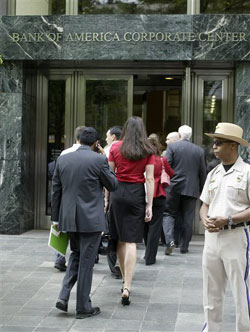| Home | Blog | Ask This | Showcase | Commentary | Comments | About Us | Contributors | Contact Us |

What in the world is going on inside Bank of America?ASK THIS | November 310, 2010There's so much we don't know about the toxic assets still being held by our biggest banks because those banks are going to incredible efforts to avoid recognizing their massive losses. The two professors who recently called for Bank of America to be put in receivership list questions everyone should be asking the bank about its practices and its holdings. By Dan Froomkin You could do a lot worse things with your time than read every word of what William K. Black and L. Randall Wray have written for the Huffington Post during the last two weeks -- even though it would take a while. Black and Wray both teach economics at the University of Missouri-Kansas City. Black, himself a regulator during the S&L scandal of the 1980s, has emerged as one of the most blistering critics of the Obama administration’s limp response to the mortgage and foreclosure crisis. For an introduction, read my article on Black and his list of nine stories the press is underreporting – most of them involving fraud, fraud and more fraud. In their first piece, back on Oct. 22, Black and Wray described how the ongoing foreclosure fraud epidemic is the work of precisely the same unrepentant bank officers whose fraudulent mortgage schemes crashed the financial system in the first place. They called on the FDIC to put some of the nation's biggest banks into receivership, in order to clean house. “Foreclose on the foreclosure fraudsters,” they wrote -- and start with the worst: Bank of America. I wrote a news story about their piece, I thought it was so important. In part two, they called for a foreclosure moratorium, and explained why the guilt gets greater the higher you go in the mortgage fraud food chain – not the other way around. Black, writing alone, also corrected President Obama’s assertion during his interview with Jon Stewart, that chief economic adviser Larry Summers had done a “heckuva job.” Summers did not resolve the financial crisis, Black wrote, he just papered over the problem. In another solo effort, Black warned that papering over the problem will actually increase the total cost of the crisis in the long run, and he concluded that “the administration's banking policies have attained the terrible trifecta: terrible economics, terrible ethics, and terrible politics.” After Bank of America executive Rebecca Mairone posted a largely nonresponsive rejoinder to Black and Wray’s call for her bank’s dissolution, the professors took to their keyboards again and wrote about how “[t]he bank's response primarily criticizes its borrowers as deadbeats, yet the data it provides support points we have made in our prior posts.” In her defense of BofA, Mairone noted that most of the bank’s problem loans were made by Countrywide Financial, which Bank of America acquired in January 2008 -- well after the toxicity of its mortgage holdings had made the company and its practices notorious. Mairone casts the action as a heroic one, staving off a failure that “would have been devastating to the economy, the markets, and millions of homeowners.” But Black and Wray argue that putting Countrywide into receivership would have been a much better option: “A receiver would have fired Countrywide's fraudulent senior leaders. Bank of America, by contrast, put them in leadership roles in major operations, including foreclosures, where they could commit continuing frauds.” And Bank of America bragged at the time of having had more than 60 people doing “due diligence” on Countrywide before the acquisition. So they knew what they were getting into; or at least they should have known. In the second part of their response to Mairone, Black and Wray called on Bank of America to come clean. And in that post, they raise some fascinating questions that all of us should be asking. Among them:
Ambac Assurance sued Bank of America in September, saying Countrywide had fraudulently induced Ambac to insure bonds backed by loans that they knew had been improperly made. This came after Ambac’s review of the underlying loans. Black and Wray ask:
As for the ongoing foreclosure crisis, in which it has become apparent that banks are forcing people out of their homes despite the absence of original, “wet ink” documentation, Mairone blamed the foreclosures on deadbeat borrowers, many of them unemployed, a third of whom no longer occupied their homes. Black and Wray asked:
|
||||||||||||




